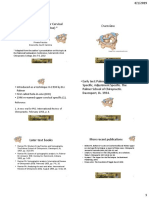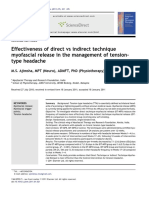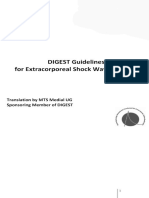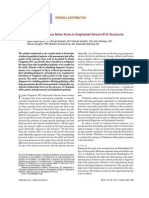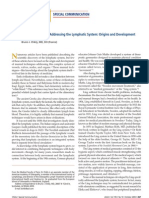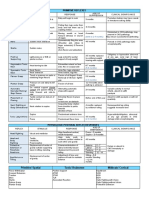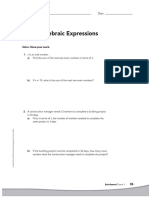Alison Grimaldi - Back in Motion Presentation - 2014 - Handout 3 Slides PP
Alison Grimaldi - Back in Motion Presentation - 2014 - Handout 3 Slides PP
Uploaded by
majd.rezkallahCopyright:
Available Formats
Alison Grimaldi - Back in Motion Presentation - 2014 - Handout 3 Slides PP
Alison Grimaldi - Back in Motion Presentation - 2014 - Handout 3 Slides PP
Uploaded by
majd.rezkallahOriginal Title
Copyright
Available Formats
Share this document
Did you find this document useful?
Is this content inappropriate?
Copyright:
Available Formats
Alison Grimaldi - Back in Motion Presentation - 2014 - Handout 3 Slides PP
Alison Grimaldi - Back in Motion Presentation - 2014 - Handout 3 Slides PP
Uploaded by
majd.rezkallahCopyright:
Available Formats
Gluteus medius
& proximal
hamstring
tendinopathy
Dr Alison Grima ldi
BPhty, MPhty(Sports), PhD
www.dra lisongrima ldi.com
Presentation
Gluteal Tendinopathy
Pain over GT
Some radiation
Impact:
Extends most commonly
down lateral thigh Sleep disturbance
Significant functional
Pain with: limitations
Sidelying Reduced activity levels
SLS eg to dress
Walking *upstairs/uphill Fearon et al 2014
Rising from sitting
Running/COD
Terminology & Pathology
Trochanteric bursitis?? ITB Thickening – 29%
- Not 1° pathology
- Only 20% of 877
- Inflammation??
Bursal distention
Gluteus medius &/or minimus
tendinopathy +/- tear
- 1° pathology
Greater Trochanteric Pain Syndrome
- Umbrella term
(Kingzett-Taylor et al., 1999; Bird et al., 2001; Connell et al., 2003; Pfirrmann et al.,
2005; Kong et al., 2007, Silva et al., 2008; Fearon et al., 2010; Long et al., 2013)
Copyright Alison Grimaldi 2014 1
Prevalence
Older In those with In those with Athletic
population LBP hip OA population
F: M 3-4:1
20-35% 20% Anecdotal
F:23.5% M:8.5%
GMT tears Runners
50-70 age group Collee et al 1991
Segal et al 2007 Tortolani et al 2002
Howell et al 2001 Step training
Prevalence
Tendinopathy PR IR
Adductor 1.22 1.13
Tendinopathy
GTPSyndrome 4.22 3.29
Jumpers Knee 1.60 1.60
Achilles 2.35 2.16
Tendinopathy
Plantar Fasciopathy 2.44 2.34
PR: prevalence rate per 100 person-years; IR: incidence rate per 1000
person-years. Albers et al 2014. Presented at recent ISTS, Oxford
Greater Trochanteric Pain Syndrome was the most
prevalent tendinopathic condition seen by GP’s in the
Netherlands in 2012.
Pathoaetiological
Mechanisms
Copyright Alison Grimaldi 2014 2
Adaptation to tension
INS
Adaptation to compression
ITB ITB thickening
Troch Bursal distention
bursa
Production of larger
proteoglycans – gel
matrix
SubGM
bursa GT
Hydrophilic
Shift to cartilage like cells
Excessive Reduces tensile
Compression loading capacity
(Almekinders et al 2003, Cook & Purdam 2012)
What causes compression at the GT?
ITB
Neutral Add/Abd 10° Add 40° Add
4N 36N 106N
(Birnbaum et al 2004)
Muscle factors
ITB Tensioners Trochanteric Abductors
Abductor Synergy
Copyright Alison Grimaldi 2014 3
Muscle factors
Increase tension in the ITB
Activity of ITB Tensioners
amplifies compressive effect
of adduction
Mechanical advantage in
adduction
ITB Tensioners
TFL, UGM, VL
Muscle factors
Better lever arm than
ITB tensioners for pelvic
control
Allow function in
minimal adduction
Trochanteric Abductors
GMed,GMin
Changes assoc with gluteal tendinopathy
Glute Med & Min atrophy Normal
TFL hypertrophy
TFL
GMin
Ant GMed
Mid
Post
Pfirrman et al 2005, Sutter et al 2012
Copyright Alison Grimaldi 2014 4
Diagnosis
Diagnostic Utility Study
Dr Alison Grimaldi1,2, Dr Rebecca Mellor2, Professor Kim Bennell3,
Professor Paul Hodges2, Professor Bill Vicenzino2
Lateral Hip Pain Trial – LEAP Trial
LEAP is funded by the National Health & Medical
Research Council Program Grant (#2012000930)
Aim: Determine the diagnostic utility of clinical
tests for gluteal tendinopathy, using MRI as
reference standard
• 60 patients with lateral hip pain
Recruit Age: 54±9yrs BMI: 28.2±kg/m2
• Battery of clinical tests (Blind to MRI)
Clin Ax
• Diagnostic MRI (Blind to Clin Ax)
MRI
• Sensitivity, Specificity, PPV, NPV, LR
Stats
Copyright Alison Grimaldi 2014 5
Clinical Test Battery
Palpation +
FABER FADER/R ADD/R SLS
+ve Test = reproduction of pain at GTrochanter
Clinical Diagnosis of Gluteal Tendinopathy (CDGT)
= +ve Palp & 1 other
PALPATION
SN SP PPV NPV +LR -LR
PALP 83 43 0.83 0.43 1.5 0.4
High sensitivity, Low specificity
Best –LR
-ve Palp Unlikely to have
gluteal tendinopathy
Sensitivity (SN): % of people with +ve MRI who test +ve on the clinical test
Specificity (SP): % of people with –ve MRI who test –ve on the clinical test
+LR: Identifies strength of test in determining who will have +ve MRI
-LR: Identifies strength of test in determining who will have -ve MRI
FABER F/ABD/ER
SN SP PPV NPV +LR -LR
FADER 46 79 0.88 0.31 1.6 0.8
Low sensitivity
Good specificity
Sensitivity (SN): % of people with +ve MRI who test +ve on the clinical test
Specificity (SP): % of people with –ve MRI who test –ve on the clinical test
+LR: Identifies strength of test in determining who will have +ve MRI
-LR: Identifies strength of test in determining who will have -ve MRI
Copyright Alison Grimaldi 2014 6
FADER 90°F/ADD to EOR/ER to EOR
FADER-R FADER + Isometric IR
SN SP PPV NPV +LR -LR
FADER 33 79 0.83 0.26 1.6 0.8
FADER-R 48 86 0.92 0.33 3.4 0.6
Low sensitivity, Good specificity
All values improved by the
addition of the active
component
Sensitivity (SN): % of people with +ve MRI who test +ve on the clinical test
Specificity (SP): % of people with –ve MRI who test –ve on the clinical test
+LR: Identifies strength of test in determining who will have +ve MRI
-LR: Identifies strength of test in determining who will have -ve MRI
ADD & ADD-R
SN SP PPV NPV +LR -LR
ADD 22 79 0.83 0.23 1.0 1.0
ADD-R 41 93 0.95 0.32 5.9 0.6
All values improved by adding
the active component
Low sensitivity, high specificity
+LR for ADD-R: Moderate effect
Sensitivity: % of people with +ve MRI who test +ve on the clinical test
Specificity: % of people with –ve MRI who test –ve on the clinical test
+LR: Identifies strength of test in determining who will have +ve MRI
-LR: Identifies strength of test in determining who will have -ve MRI
SLS Sustained single leg stance (30s)
SN SP PPV NPV +LR -LR
SLS 42 100 100 0.34 58.6 0.6
Greatest diagnostic utility
Low sensitivity
Excellent specificity
+LR >50 = large and often
conclusive shifts in probability
Sensitivity (SN): % of people with +ve MRI who test +ve on the clinical test
Specificity (SP): % of people with –ve MRI who test –ve on the clinical test
+LR: Identifies strength of test in determining who will have +ve MRI
-LR: Identifies strength of test in determining who will have -ve MRI
Copyright Alison Grimaldi 2014 7
Diagnostic tests
Lateral hip pain within Very likely to have
30 s of SLS gluteal tendinopathy
SLS, FADER-R, ADD-R Greatest diagnostic
(involve muscle cont) utility
Non-tender over GT on Unlikely to have gluteal
palpation tendinopathy
All tests, except palp,
had poor sensitivity ?? Poor tests
MRI is a poor predictor of
symptomatic tendon/bursal
pathology at the lateral hip
Blankenbaker et al 2008
90% of patients scanned for hip pain
have MR changes at the GT
Only 6% had lateral hip pain
(N=256)
Clinical tests may be more useful than
MRI for detecting a clinically positive
pathology
Hip Abductor functional deficits
SLStance SLS Gait
Excessive hip add – pelvic lateral tilt and/or shift
Trunk lateral flexion/shift
Copyright Alison Grimaldi 2014 8
Management
Traditional Management
Anti-inflammatory Stretching
treatment
RATIONALE??
Commonly prescribed exercises
Compression issues
Open chain strengthening
appears to bias superficial
musculature
Copyright Alison Grimaldi 2014 9
Contemporary Management
Decompression Exercise
Minimise amount of Optimise muscle
compression over each function & tendon
24 hour period loading
Decompression
MINIMISE:
Sustained, repetitive, or loaded
HIP ADDUCTION
HIP FLEXION > 90°
HIP FLEXION/ADD
HIP OUT KNEE ACROSS THE BODY
Decompression
Copyright Alison Grimaldi 2014 10
Decompression: Sleeping
Decompression: Stretching
Exercise:
Graduated tensile loading under minimal compression
1. Isometric Abduction
2. Femoro-pelvic Control
during Functional Loading
3. Low Velocity-High
Load Abduction
Copyright Alison Grimaldi 2014 11
Isometric Abduction
1. Improve motor control *trochanteric abductor
activation
Low load, low velocity exercises requiring focused attention
more effective in creating neuroplastic change & improvements in
motor control than general exercise (Tsao et al., 2010; Tsao & Hodges, 2007)
2. Reduce Pain
Sustained low intensity (25% MVIC) isometric contractions were
found to raise pressure pain thresholds (i.e. reduce pain
sensitivity)
(Hoeger Bement et al, 2008)
Functional retraining
Double leg Offset Squat Single Leg Single leg Step Up
squat Stance squat
Teach to control adduction during functional tasks such as
single leg stance, stair climbing, gait.
Also provides graduated increase in abductor loading
WB provides stimulus to deeper trochanteric abductors
Low Velocity-High Load Abduction
Weightbearing – positive for balance within synergy
Inner range abd– reduced mechanical advantage of sup abd’s
Allows graduation to high tensile loads with no compression
Copyright Alison Grimaldi 2014 12
Home Alternatives
Sidestepping Doorway sideslides
Proximal Hams Tendinopathy
Presentation
Ischial pain
+/- post thigh pain or tightness
+/- paraesthesia post thigh
Often misdiagnosed as sciatica
Pain with:
Sitting, esp on hard surfaces,
Forward lean activities
Stairs, Walking esp uphill
Running – uphill, higher speeds
Patho-aetiology
Compression
Compression is key
deep tendon fibres
against ischium
(Cook & Purdam 2012)
*semimembranosis
Copyright Alison Grimaldi 2014 13
Patho-aetiology
SM
ST&BF
SM ST BF
Anatomical models © Primal Pictures Ltd
Compression in hip flexion
* with muscle active
* with muscle & tendon at length
Increased use of hip flexion
may be associated with:
Excessive hip mobility
Habit
Ankle or knee restrictions
– unable to use triple flexion
Quads weakness
Effect of trunk inclination
Difficulty achieving
trunk upright
posture if:
Tightness of:
Calves/Ankles
Hip flexors/Jt
Weakness of:
Glute Max
Trunk Extensors
Copyright Alison Grimaldi 2014 14
Effect of lower gluteal atrophy
Increased hams workload
Reduced padding over ischial tuberosity in sitting
Asymmetric atrophy
Axial MRI
- pelvic obliquity in
sitting
- increased load on IT
IT
affected side
GMax GMax
R
Diagnosis
Standing forward lean
+ve – reproduction of pain over ischium +/- thigh pain
Neck F/E to help differentiate SN
Bilateral Unilateral
HIGH LOAD esp if add step
& speed, or load
Copyright Alison Grimaldi 2014 15
Heel Drag & Shoe Off
Symptoms of pain/discomfort at ischium
Standing Heel Drag Taking Off The Shoe Test
Bowman et al 2013 Reiman et al 2013
Isometric
hams
contraction
Puranen-Oravo Test
Symptoms of pain/discomfort at ischium
Stretch forward
Puranen & Oravo 1988
Cacchio et al 2012
Reiman et al 2013
Bent Knee Stretch
Maximal hip flexion + slow knee
extension to EOR or P1
Fredericson et al 2005
Modified Bent Knee Stretch
As above except the examiner
rapidly extends the knee
Cacchio et al 2012
Reiman et al 2013
Cacchio et al 2012
Copyright Alison Grimaldi 2014 16
BKS + Active Loading
Active load superimposed on passive compression
+ Isometric knee flexion + Single leg bridge
Palpation
SM
CO
Copyright
Primal Pictures
Contemporary Management
Decompression Exercise
Minimise amount of Optimise muscle
compression over each function & tendon
24 hour period loading
Copyright Alison Grimaldi 2014 17
AVOID
Hard chairs Stretching Forward lean
Hip F + Knee Ext or loading hams & bending from hips
on stretch
Decompression
Substitute with:
Exercise
Aims:
Reduce Pain
Address motor control issues
- excessive low load hamstring activation - guarding
- poor gluteus maximus activation
- lumbo-pelvic control
Load musculo-tendinous complex – Hip extensors
- Reverse atrophy
- Improve tensile loading capacity of hamstring tendons
- Improve ability of hamstrings to lengthen under load
Copyright Alison Grimaldi 2014 18
Exercise:
1. Isometric Hams/Glutes
4 x/day; 10-45 secs; 5-10reps
2. Graduated Loading of
hip extensors
Low load daily
High load 3 x/wk
3. Lengthening under load
1-3x/week
Petersen et al 2011, AJSM 39(11)
for Nordics programme
Bridging
Double leg Offset Single foot Single leg Single leg
hover extensions dips
No posterior pelvic tilt – neutral Lx,
Gently preset lower glute max
Purpose - Lower limb patterning
- Strengthening glute max and hamstrings
Bridging with
higher hamstring bias
Allows more advantageous length tension relationship for
hams
Copyright Alison Grimaldi 2014 19
Lengthening under load
Functional retraining
Double leg Offset Squat Single Leg Single leg Split lunge Step Up
squat Stance squat
Functional WB progressions
Minimise functional adduction
Initially minimise depth & fwd trunk inclination due to compression
Purpose - Lower limb patterning – improve fem-pelvic control
- Graduated increase in hip extensor loading
Other associated muscle groups
Hip abductor strengthening & Hip flexor strengthening &
endurance endurance
Inadequate pelvic control may To improve knee lift, and
result in increased use of thigh enhance ability of hip flexors to
musculature to stabilise from provide an increase in cadence,
below
as required
Copyright Alison Grimaldi 2014 20
AVOID
Hamstring loading in hip flexion
AVOID
Hamstring stretching should be avoided
Cook & Purdam 2012, Lempainen et al 2009
Use massage, trigger point release, acupuncture/needling
Take Home Messages
Compression esp under high tensile loads
- High exposure - negative loading environment for
insertional tendons
- Useful for diagnostic testing
- Advise patients to avoid/minimise these loads
- Avoid/minimise these loads during
exercise/activity
Copyright Alison Grimaldi 2014 21
Thank You
For further information
e: info@physiotec.com
Online Learning/Courses:
www.dralisongrimaldi.com
Copyright Alison Grimaldi 2014 22
You might also like
- EmSAT English HCT Preparation Course Practice Material PDFDocument81 pagesEmSAT English HCT Preparation Course Practice Material PDFBatool Mahmoud77% (30)
- Neurofunctional Blueprints Transcripts For Tempe, January 2015 PDFDocument82 pagesNeurofunctional Blueprints Transcripts For Tempe, January 2015 PDFAnonymous oCjRxyBP100% (3)
- Facilitated Positional Release FPRDocument12 pagesFacilitated Positional Release FPRcoahuiltecoNo ratings yet
- Unit Operation: Experiment 6: Solid Mixing of Granular Material and Powdered Foods by Using V-Cone MixerDocument7 pagesUnit Operation: Experiment 6: Solid Mixing of Granular Material and Powdered Foods by Using V-Cone MixernajwaNo ratings yet
- Chiro HIODocument18 pagesChiro HIOPierre SERPAGGINo ratings yet
- Spinal Care and Its Effects On Human Physiology in Sickness and in HealthDocument196 pagesSpinal Care and Its Effects On Human Physiology in Sickness and in HealthMichael Koontz67% (3)
- Everything You Wanted to Know About the Back: A Consumers Guide to the Diagnosis and Treatment of Lower Back PainFrom EverandEverything You Wanted to Know About the Back: A Consumers Guide to the Diagnosis and Treatment of Lower Back PainNo ratings yet
- Instructional Guide For The Arcgis Book 2eDocument387 pagesInstructional Guide For The Arcgis Book 2eZana Karić100% (1)
- UNIVERGE SV9100 Hardware Manual - Issue 9.1Document574 pagesUNIVERGE SV9100 Hardware Manual - Issue 9.1TonyNo ratings yet
- TOGAF 9 Summary of Study GuideDocument23 pagesTOGAF 9 Summary of Study GuideJuan K Luna100% (1)
- Elbow Anatomy, Assessment & Differential Diagnosis With Nick Kendrick HandoutDocument24 pagesElbow Anatomy, Assessment & Differential Diagnosis With Nick Kendrick Handoutgemichan26No ratings yet
- Efficacy of Sot in FemalesDocument7 pagesEfficacy of Sot in FemalesDenise MathreNo ratings yet
- The Painful Dysfunctional ShoulderDocument3 pagesThe Painful Dysfunctional ShoulderAnanta Resti AyundariNo ratings yet
- Hips Pelvis PR PDFDocument19 pagesHips Pelvis PR PDFluulaaNo ratings yet
- Cat 2Document5 pagesCat 2Edgardo BivimasNo ratings yet
- Puntos Gatillo-Dolores de CabezaDocument63 pagesPuntos Gatillo-Dolores de CabezaRobertoLópezCabreraNo ratings yet
- Gonstead Ifec Side PostureDocument19 pagesGonstead Ifec Side PostureAurelien BoschatNo ratings yet
- Case Study: Mulligan Concept Management of "Tennis Elbow"Document3 pagesCase Study: Mulligan Concept Management of "Tennis Elbow"noonoons100% (1)
- LymphaticDocument52 pagesLymphaticlemuel_queNo ratings yet
- WWW - Chiropractic SportsDocument5 pagesWWW - Chiropractic Sportsapi-3714923No ratings yet
- Myths of The SIJ 2006Document14 pagesMyths of The SIJ 2006César Alejandro Martínez RetamalNo ratings yet
- 4) Lumbar Spinous Push Technique (Type IV), Iliomamillary PushDocument3 pages4) Lumbar Spinous Push Technique (Type IV), Iliomamillary PushNoorAkNo ratings yet
- 10 Knee MobilizationDocument12 pages10 Knee MobilizationGautamNo ratings yet
- Ebook Lumbar TractionDocument6 pagesEbook Lumbar TractionMskola KarlovacNo ratings yet
- Activator TestingDocument88 pagesActivator TestingRamon Alberto Portillo MedinaNo ratings yet
- ManualDocument95 pagesManualcristina_c_43No ratings yet
- Gonstead Ifec ProneDocument5 pagesGonstead Ifec ProneAurelien BoschatNo ratings yet
- MM SS Bruggers Seated StretchDocument1 pageMM SS Bruggers Seated StretchFernandoNo ratings yet
- Rehabilitation Will Increase The Capacity of Your Insert Musculoskeletal Tissue Here Defining Tissue Capacity A Core Concept For CliniciansDocument3 pagesRehabilitation Will Increase The Capacity of Your Insert Musculoskeletal Tissue Here Defining Tissue Capacity A Core Concept For CliniciansChristhoper HermosillaNo ratings yet
- 2014 Helsinki Workshop Material ShacklockDocument43 pages2014 Helsinki Workshop Material ShacklockAl100% (1)
- Shoulder Physical ExamDocument34 pagesShoulder Physical ExamSultan VIINo ratings yet
- 13 - Neural MobilizationDocument19 pages13 - Neural MobilizationAhmed MuflehNo ratings yet
- Chiropractic - in New Zealand - Report 1979Document398 pagesChiropractic - in New Zealand - Report 1979vicarofskeptic100% (1)
- Lesson 4 NotesDocument4 pagesLesson 4 NotesOscar NgNo ratings yet
- Reinold - Glenohumeral and Scapulothoracic RehabDocument45 pagesReinold - Glenohumeral and Scapulothoracic Rehabshivnair100% (3)
- Brochure ChiropracticDocument8 pagesBrochure ChiropracticLiana MarNo ratings yet
- Treatment of Osteitis Pubis Via The Pelvic Muscles PDFDocument4 pagesTreatment of Osteitis Pubis Via The Pelvic Muscles PDFHapplo82No ratings yet
- Fascial StrechDocument26 pagesFascial StrechDenislav SpasovNo ratings yet
- Thompson Technique Documentation ListingsDocument4 pagesThompson Technique Documentation ListingsCNPOULISNo ratings yet
- Gmi PDFDocument71 pagesGmi PDFAlma GlinacNo ratings yet
- Effectiveness of Direct Vs Indirect Technique Myofascial Release in The Management of Tensiontype HeadacheDocument5 pagesEffectiveness of Direct Vs Indirect Technique Myofascial Release in The Management of Tensiontype Headachekapturzak100% (1)
- Wrist Ankle AcupunctureDocument3 pagesWrist Ankle AcupunctureYoshua ViventiusNo ratings yet
- Hip Pain Dry Needling Versus Cortisone InjectionsDocument1 pageHip Pain Dry Needling Versus Cortisone InjectionsNicolás Ayelef ParraguezNo ratings yet
- CV4 EfectDocument21 pagesCV4 EfectNicole HermosillaNo ratings yet
- ISMST GuidelinesDocument112 pagesISMST GuidelinesDhrubo TaraNo ratings yet
- Fascial Stretch TherapyDocument330 pagesFascial Stretch TherapyЕвгений хххNo ratings yet
- Clinical Examination of The Shoulder: Chapter Contents Referred PainDocument13 pagesClinical Examination of The Shoulder: Chapter Contents Referred Painvein94No ratings yet
- Chapmans Reflex 479Document5 pagesChapmans Reflex 479Huram-abi0% (1)
- Ligamentous Articular Strain - Osteopathic ManipulativeDocument20 pagesLigamentous Articular Strain - Osteopathic Manipulativeisa_martínezNo ratings yet
- Chap 4. Manual Therapy For Thoracal SpineDocument31 pagesChap 4. Manual Therapy For Thoracal SpineMita SuryatniNo ratings yet
- Vol 22 1 A.A.O.JOURNAL March2012Document92 pagesVol 22 1 A.A.O.JOURNAL March2012hicham boulaamani100% (1)
- Myotmes DermatomesDocument25 pagesMyotmes Dermatomesdsdfsa100% (1)
- Effect of Maitland Spinal Mobilization Therapy Versus Conventional Therapy in Lumbar Spondylosis With RadiculopathyDocument8 pagesEffect of Maitland Spinal Mobilization Therapy Versus Conventional Therapy in Lumbar Spondylosis With RadiculopathyjuancaNo ratings yet
- Tennis Elbow Bill 2015 PDFDocument8 pagesTennis Elbow Bill 2015 PDFDiegoKosiakNo ratings yet
- Chapmans Reflex 457Document8 pagesChapmans Reflex 457Huram-abiNo ratings yet
- Trigger PointsDocument26 pagesTrigger Pointsapi-459697337No ratings yet
- Updated Report of 3 28 Wtih Fixed BiblioDocument26 pagesUpdated Report of 3 28 Wtih Fixed BiblioRoderley ReisNo ratings yet
- Primitive Reflexes: (Birth To 2-4 Months)Document3 pagesPrimitive Reflexes: (Birth To 2-4 Months)Mic De Castro NaguitNo ratings yet
- Passive Scapular Adduction TestDocument15 pagesPassive Scapular Adduction Testapi-468597987No ratings yet
- Physiotherapy Treatment of Shoulder Pain - REHABILITATION PRINCIPLES. Today S Topics. Rehabilitation of Rotator Cuff TendinopathyDocument32 pagesPhysiotherapy Treatment of Shoulder Pain - REHABILITATION PRINCIPLES. Today S Topics. Rehabilitation of Rotator Cuff TendinopathyWalter PelaezNo ratings yet
- MWM and Dry NeedlingDocument7 pagesMWM and Dry NeedlingAnanta MiaNo ratings yet
- In Demand: The Health Professionals Guide to a Winning PracticeFrom EverandIn Demand: The Health Professionals Guide to a Winning PracticeNo ratings yet
- Unlocking Pathways of Pain: Stories of Innovative Treatments and How They WorkFrom EverandUnlocking Pathways of Pain: Stories of Innovative Treatments and How They WorkNo ratings yet
- GRAZIERS_GRILL_HOUSE_MENU_2024_WINTER_9Document2 pagesGRAZIERS_GRILL_HOUSE_MENU_2024_WINTER_9majd.rezkallahNo ratings yet
- Modern Tendinopathy ManagementDocument23 pagesModern Tendinopathy Managementmajd.rezkallahNo ratings yet
- Achilles Tendinopathy Not One DiagnosisDocument21 pagesAchilles Tendinopathy Not One Diagnosismajd.rezkallahNo ratings yet
- New Eccentric Training For Insertional Achilles Tendinopathy - AllfredsonDocument5 pagesNew Eccentric Training For Insertional Achilles Tendinopathy - Allfredsonmajd.rezkallahNo ratings yet
- Achilles Tendon Rehab-Peter MalliarisDocument1 pageAchilles Tendon Rehab-Peter Malliarismajd.rezkallahNo ratings yet
- Trish Wisby-Roth Dynamic Slings and Optimal 3D FunctionDocument14 pagesTrish Wisby-Roth Dynamic Slings and Optimal 3D Functionmajd.rezkallahNo ratings yet
- HS Tendinopathy Rehab GoomDocument32 pagesHS Tendinopathy Rehab Goommajd.rezkallahNo ratings yet
- 2009 Marathon INTERMEDIATE Training DiaryDocument12 pages2009 Marathon INTERMEDIATE Training Diarymajd.rezkallahNo ratings yet
- APA Spinal 1 Motor Control 20140323Document94 pagesAPA Spinal 1 Motor Control 20140323majd.rezkallahNo ratings yet
- Tan v. Barrios DigestDocument2 pagesTan v. Barrios Digestayhen01No ratings yet
- Iesve For EngineersDocument7 pagesIesve For Engineerselezm0% (1)
- Enrich Chap7Document6 pagesEnrich Chap7hmtuanbkNo ratings yet
- That Said Tiananmen 89Document2 pagesThat Said Tiananmen 89DRSD MK3No ratings yet
- Chapter 2 Schoeder - Operations and Supply Chain StrategyDocument19 pagesChapter 2 Schoeder - Operations and Supply Chain StrategyMuhamad FuadNo ratings yet
- AlbanianLife 24 1983 OCR SMDocument52 pagesAlbanianLife 24 1983 OCR SMab theproNo ratings yet
- Child Development EssayDocument7 pagesChild Development EssaySharmeen ParanthamanNo ratings yet
- 124hOLYY SPiritDocument2 pages124hOLYY SPiritnicaella pedroNo ratings yet
- The Ultimate Color Combinations Cheat SheetDocument8 pagesThe Ultimate Color Combinations Cheat SheetproblemcauserNo ratings yet
- Minor Project SynopsisDocument63 pagesMinor Project Synopsisgovardhandangi0677No ratings yet
- Fostering Organizational Communication - XTDocument26 pagesFostering Organizational Communication - XTSharanya PaulNo ratings yet
- Mam Merly SHTA DFTA-SIGNIFICANT-POINTS IRISH V DE RAMA, EdD, JD, DHumDocument7 pagesMam Merly SHTA DFTA-SIGNIFICANT-POINTS IRISH V DE RAMA, EdD, JD, DHumCALAUAN MPES DISTRICT-IRISH DE RAMANo ratings yet
- Ready To Progress AssessmentDocument4 pagesReady To Progress AssessmentThao Le - MDE SpecialistNo ratings yet
- Ten Effective Way of Managing PeopleDocument3 pagesTen Effective Way of Managing PeopleLouis Fetilo FabunanNo ratings yet
- Cyber Secured Web Development AssociateDocument1 pageCyber Secured Web Development AssociatemyselfbighnarajpatiNo ratings yet
- Kalimat Elips DLL Doc1662777588Document4 pagesKalimat Elips DLL Doc1662777588Adinda JolisaNo ratings yet
- Deep Bed Filter Unit: Technical Teaching EquipmentDocument3 pagesDeep Bed Filter Unit: Technical Teaching EquipmentJennifer MaamaryNo ratings yet
- Môn TH 2Document18 pagesMôn TH 2Kookie KookieNo ratings yet
- Sas #5 - His 007Document7 pagesSas #5 - His 007Joemil GunayanNo ratings yet
- Aditya ProjectDocument60 pagesAditya Projectroy426123No ratings yet
- Test Format - Reading & Writin IELTS GeneralDocument10 pagesTest Format - Reading & Writin IELTS GeneralLaura TrifanNo ratings yet
- Retrieval Augmented Generation - A Simple IntroductionDocument82 pagesRetrieval Augmented Generation - A Simple IntroductionakashpolNo ratings yet
- Brotherhood Club 2015 ProposalDocument9 pagesBrotherhood Club 2015 ProposalO AfricaNo ratings yet
- Medical Veterinary Sales Manager in Richmond VA Resume Gary WeissgoldDocument1 pageMedical Veterinary Sales Manager in Richmond VA Resume Gary WeissgoldGaryWeissgoldNo ratings yet
- Damages Under IndemnityDocument16 pagesDamages Under IndemnityAdvaith Govind0% (1)




